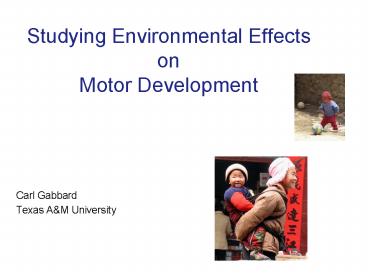Studying Environmental Effects on Motor Development - PowerPoint PPT Presentation
1 / 27
Title:
Studying Environmental Effects on Motor Development
Description:
Comparatively little research has addressed one of the primary determinants of MD ... Process (play time / type, physical education, sport) ... – PowerPoint PPT presentation
Number of Views:183
Avg rating:5.0/5.0
Title: Studying Environmental Effects on Motor Development
1
Studying Environmental Effects onMotor
Development
- Carl Gabbard
- Texas AM University
2
Comparatively little research has addressed one
of the primary determinants of MD - Environment
3
Intent
- to highlight the role of the environment in the
study of MD - describe a contemporary model for research
- consider examples of (for) research
4
Developmental Systems Perspective
- Human Development is the product of changing
relations between the developing person and his
or her changing multi-level environmental
contexts
(Lerner, 2002)
5
What is Motor Development?
- Study of change in motor behavior and underlying
processes as influenced by biological and
environmental factors - environmental contexts
- biological systems
6
The first assumption of the dynamic
approach is that developing organisms are complex
(self-organizing) systems the coherence is
generated solely in the relationships between the
organic components and the constraints and
opportunities of the environment.
Smith Thelen (2003) Trends in Cognitive
Sciences
7
Environmental Effects An optimal level of
development occurs only with a stimulating
environment and strong contextual support (e.g.
Diamond Hopson, 1998 Fischer Rose, 1998
Ramey Ramey, 1998). The National Academies
(January, 2000) Research indicates that early
relationships are especially critical, and that
cultural values and practices provide the
context for these bonds.
8
Newells Constraints Model
9
Gibsons Ecological Perspective
- Infants directly perceive and act on
information - via
- affordances
- in environment
10
- Affordance (Gibson, 1979)
- Theory explores the potential relationships
between person-environment - Properties of the environment that offer the
individual the opportunity to learn or utilize a
skill or develop a part of the biological system - Affordances are opportunities that offer the
individual potential for action, and consequently
to learn and develop a skill or a part of the
biological system (Heft, 1997 Hirose, 2002
Stoffregen, 2000).
11
Affordances include toys, materials,
apparatus, availability of space, stimulation and
nurturing by parents and others Events offer
the child opportunities for action. Hirose
states, Affordances are opportunities for action
that objects, events, or places in the
environment provide for the animal, (p. 104).
12
- Affordances
- Action depends on (task)
- developmental level
- experience
- present need
- cognitive awareness Ecological Fit
Studies, e.g., Adolph, 1993, 1995, 2007
13
Urie Bronfenbrenner
- Ecological Systems Theory
- The varied systems of the environment and the
interrelationships among the systems shape a
child's development. - Both the environment and biology influence the
child's development. - The environment affects the child and the child
influences the environment.
Bronfenbrenner U. (1979, 1989. 2005)
14
Ecological Systems Model
- the person interacts with ecological contexts as
part of a system. That is, the person acts on the
context while the context acts on the person. To
some extent, all the contexts interact with one
another - the world of the child (and indeed all of us)
consists of five systems of interaction - each system depends on the contextual nature of
the persons life and offers an evergrowing
diversity of options and sources of growth
15
Systems Model
- Microsystem
- Mesosystem
- Exosystem
- Macrosystem
- Chronosystem
person
Bronfenbrenner U. (1979, 1989. 2005)
16
increasing focus on the child (bio)
17
microsystem -- the most immediate and earliest
influences is the family, along with local
neighborhood or community institutions such
as the school, religious institutions and peer
groups as well as the specific culture
with which the family identifies.
macrosystem -- society and global influence
Huitt (2003)
18
Research
- Swick Williams, 2006, use of model
- Harney, 2007, use of model
- Liles Juhnke, 2008, adolesc. diabetes
- (Process-Person-Context-Time Model)
- Yu Stiffman, 2007, alcohol abuse
- (family, social, cultural)
- Garcia Saewyc, 2007, mental health
- (cultural, community services)
- Schwebel Brezausek, 2007, pediatric injury
- (family home, and child care
environment)
23 dissertations in 2007 (ProQuest)
19
Salmon Timperio, 2007, Med Sport Sci,
physical activity (neighborhood social and
physical environment) Gilmer et al., 2003, J
Pediatric Nurs, physical activity
(peers, family, community)
Movement Science
- Bronfenbrenners model provides a
comprehensive and dynamic conceptual - framework for understanding human
development (Bengoechea, Quest, 2002)
20
- Process-Person-Context-Time (PPCT) ecological
model
Bronfenbrenner, 2005
21
(PPCT)
- Process fused and dynamic relation of the person
- and context
- Person biological, cognitive, and emotional
characteristics - Context nested levels or systems of the ecology
- Time multiple dimensions of temporality
22
(PPCT) example A
Environmental influence on physical activity /
fundamental motor skills
Person (fitness, FMS characteristics) Process
(play / sport, physical education, recess - time
/ freq) Context (SES, family father, mother
community facilities, access, safety, crime,
urban design) Time (K gt 2, childhood gt
adolescence)
23
(PPCT) example B
The relation between early motor development and
early cognitive ability
Person (birth status, fine- and gross motor
ability, cognitive..) Process (play time /
type, physical education, sport) Context (SES,
family father, mothereducation, alcohol,
pa level, home environ., community
facilities, access, urban design) Time
(early childhood gt school age years)
24
MD in context
neighborhood
SYSTEM
school
family
behavior
behavior
child
Time 1 TIME Time 2
PROCESS
25
The AHEMD-SR
- Affordances in the Home Environment for Motor
Development (AHEMD-SR) - A unique observational research instrument to
assess the quality and quantity of motor
development affordances in the home for children
3- to 42 months
Rodrigues et al., 2005, 2008)
26
(No Transcript)
27
Thank you!































